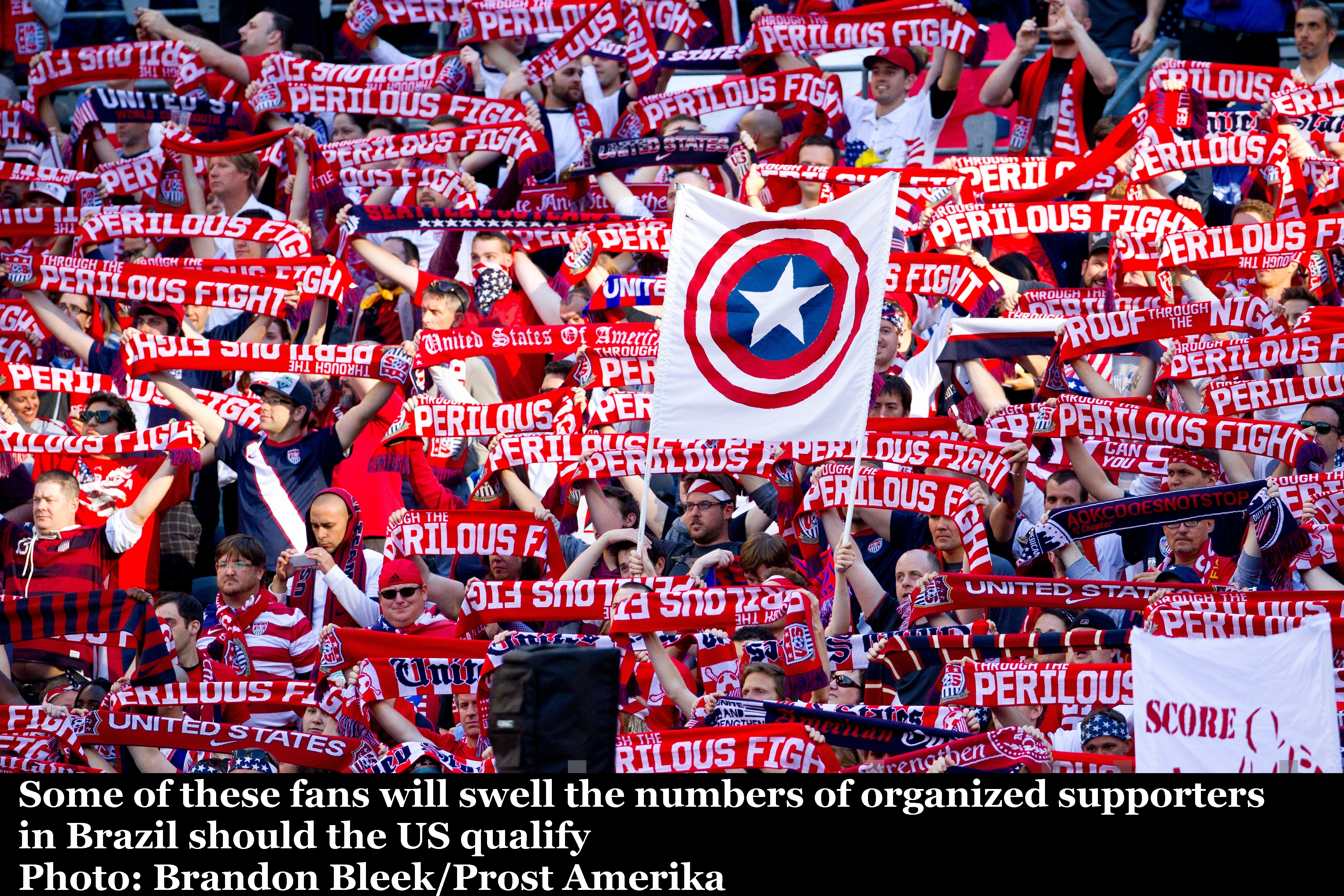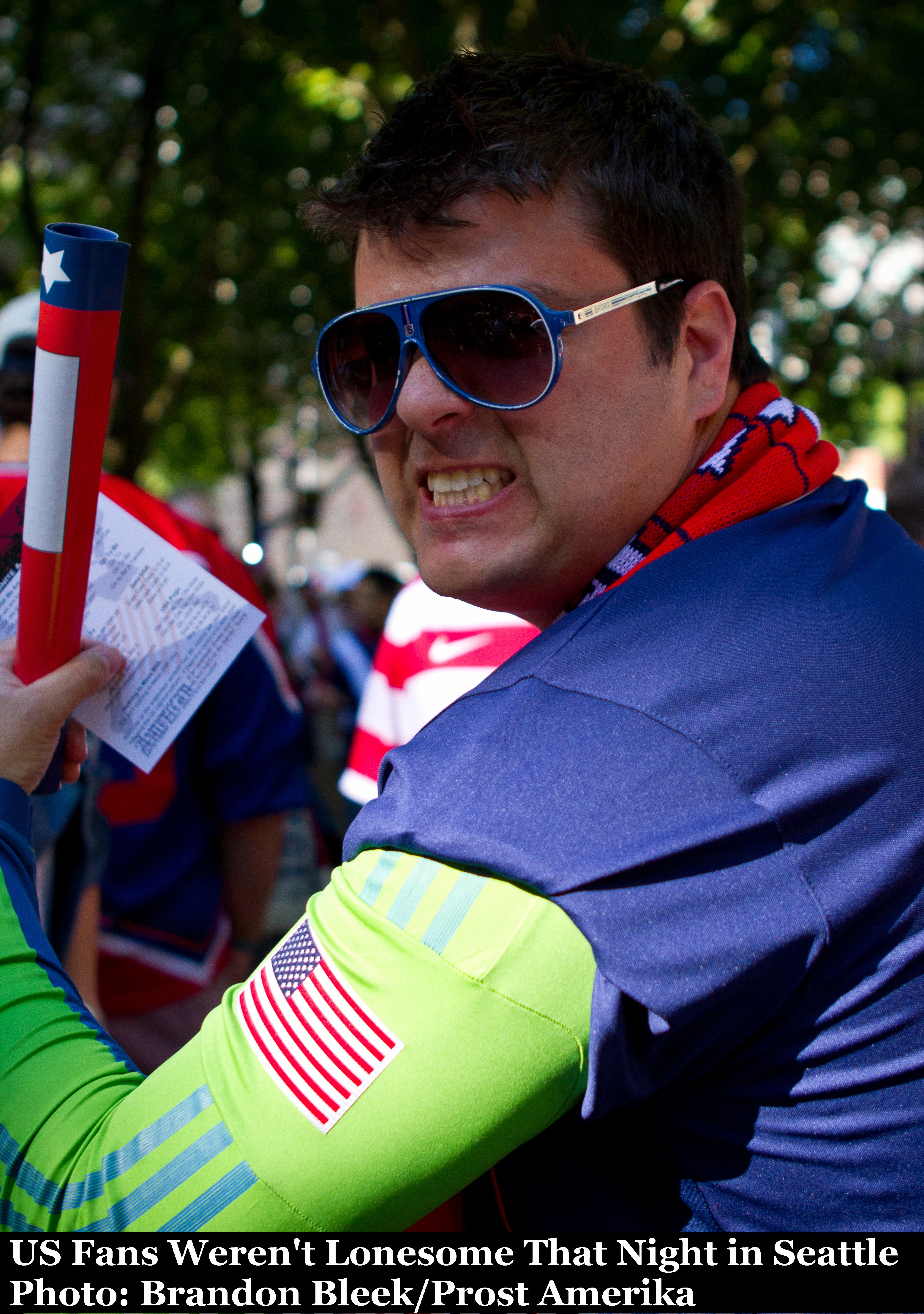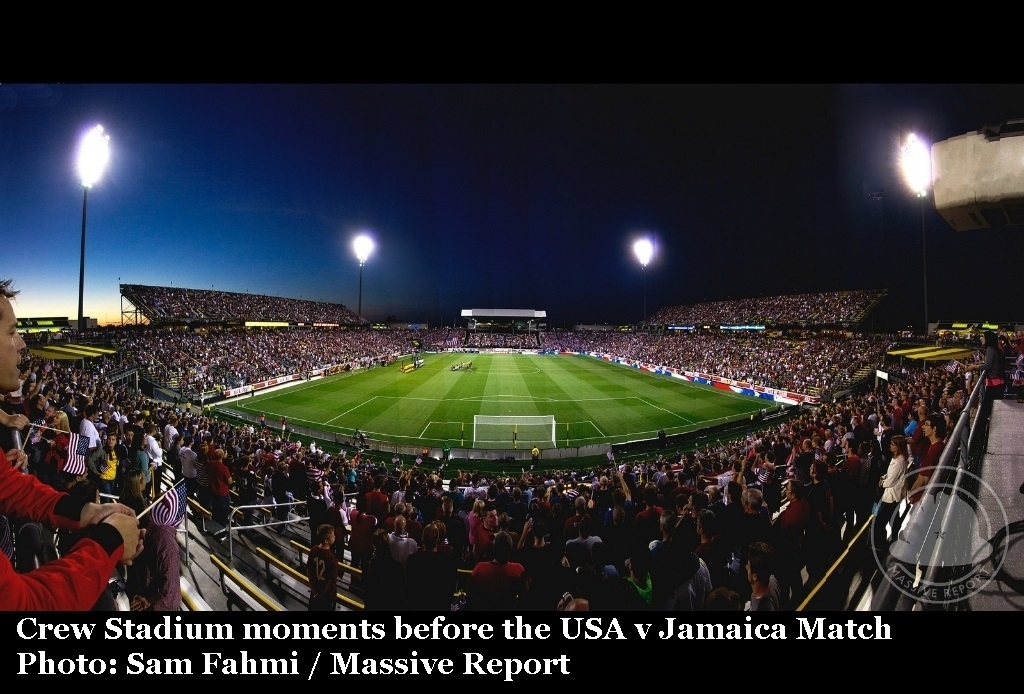
The rise in the popularity of Supporter Culture in North America has been well documented recently.
Major League Soccer and the mainstream media have followed the clubs' lead in using fan generated noise and tifo as a marketing tool after years of regarding fans who chant and sing with extreme suspicion.
Individual Supporters Groups (SGs) such as the Angel City Brigade, Riot Squad and Galaxians (LA Galaxy), the Hudson Street Hooligans (Columbus), the Casbah (San Jose), Barra Brava (DC) and the Empire Supporters Club (New York) carried the movement but were largely ignored by the mainstream media and often, as in New England, had to deal with as certain amount of (let's be kind and say) discouragement from their own Front Office.
There are other SGs who deserved mention. I couldn't list them all and I'd accept that there may be others who deserve recognition that were omitted.
Still, these activities were predominantly thought a niche subculture until the arrival of Toronto FC and its Red Patch Boys and U Sector SGs. Toronto's cultural and geographic proximity to Europe helped these SGs to provide the next spurt in supporter culture growth.
Their estimated 2000 travelling fans to a game in Columbus in 2008 remains a MLS record, though Portland may have some claim to have come close to that on Sunday. This is by no means intended to dismiss the activities of Supporters Groups outside the league such as Ralph's Mob in Tampa Bay. There is life, significant life, beyond MLS.
That boost to the art of organized supporting was augmented by the next four arrivals; Seattle, Philadelphia, Portland, and Vancouver. It is hard to imagine home games in those cities without a healthy dose of noise from behind one goal, colorful tifo and social lives revolving around what the Germans call their "Fussballfreunde" (football friends).
True, in Vancouver it was initially a struggle, but the Southsiders are still here and their one time nemesis Paul Barber is in Brighton.
However, there was one team where this movement remained largely stagnant and where the home team was still regularly outsupported and outsung at home games. That side was the US Mens National Team.
Until recently that is.
On September 10 in Columbus there will be 9000 organized United States fans, easily trumping whatever the previous record was if it had ever been measured. The main water carriers of this 'rushing revolution' are a group called the American Outlaws, a Supporters Group dedicated to cheering on the US National Team.
Where once US international matches at home were characterized by the away sides -- especially Mexico -- having more vocal support, things have changed. A series of factors have contributed to that starting with a less altruistic choice of home venue by US Soccer.
In the past, US Soccer put matches where supporters of the away side could attend most easily and fill both the stadium and US Soccer's coffers. Not any more. They now look to cities where they can fill the stadium with American fans. That accounts partly for the change.
The rise in organizational skills adopted by the Outlaws took care of the rest. Even that in itself, did not happen in isolation and there are really two parts to that story. It sprang off the growth of organized Supporter Culture at MLS matches. Those club fans who developed their organizational abilities week after week began to apply those lessons to the national level and grow the Outlaws' vocal and visible presence at US matches. The internet of course sped up the communication of ideas.
Dylan Vanderhoof is a typical example of that process. He assisted in the production of the AO tifo at the recent Seattle v Panama game. In an article for the ECS site, he explained how the AO Seattle borrowed from the Sounders ECS group while remaining at arms' length. This allowed many Seattle resident who were fans of other clubs to become involved:
"While many of the people who contributed to the AO tifo display put up before the Panama match were part of the regular ECS tifo production crew, a fairly large percentage were new and wanted to help out because it was the USMNT.
Aside from the ECS allowing the use of some of their infrastructure, the display was all AO in design, feel, and production. During deployment, there was even a Timbers Army capo pressed into the service to help out with some of the deployment logistics and cueing. I have a feeling the SG separation made things like that possible by stressing the point that for that night, we were all American Outlaws."
Away from match day, the second part of the expansion took place in small bars around the nation as the Outlaws who had traveled across the country to matches took chants and ideas back to cities and towns beyond the 15 American cities with clubs in the USA.
 One man who experienced that process at first hand is Fredo Boron, a member of the AO San Jose branch who started attending US home games in 2011 when Chile visited the LA Galaxy's Stadium, in some parts due to the selection of his San Jose Earthquakes hero Chris Wondolowski. That was at least the initial attraction to travel.
One man who experienced that process at first hand is Fredo Boron, a member of the AO San Jose branch who started attending US home games in 2011 when Chile visited the LA Galaxy's Stadium, in some parts due to the selection of his San Jose Earthquakes hero Chris Wondolowski. That was at least the initial attraction to travel.
He attended the Seattle game two years later, but in between was active in the Outlaws' viewing parties. When asked what changes he had seen in two short years, Boron noted:
"I have been to two AO games and a few AO events, but I have noticed quite a few contrasts in comparison of my first game which was in 2011, a US vs Chile friendly (also Wondo's first game in a US jersey) and the recent World Cup Qualifier in Seattle, as well as some similarities. I recalled from the first game how disorganized the chanting was, which made sense considering there was no capo. I also remember how little often we would all sing in unison.
I think the only song we managed to chant as a group was the "we love you, we love you" chant and the rest of the time it would be pockets of silence or songs coming from one section while at the same time a different song would chanted from another direction. The game wasn't too impressive and it didn't help that the support wasn't creating any better of an atmosphere either."
That was then, and Boron credits a large part of the improvement to the Outlaws' creation of organized viewing parties around the nation:
"After that game I went to some viewing parties and events, and one thing about AO events are that they let you interact with soccer fans from all over the country and it's those interactions with different supporters that allow you to share your experiences about being a supporter and your local soccer culture.
You discover as many differences as you do similarities, but it is the differences that are allowing supporters to conduct their own natural selection process to discuss what they would like to adapt. So with that, I found as AO becomes stronger and its influence spreads, so does the growth of supporter culture in the States, which is made evident with its recognition by MLS, USMNT, and a lot of the media covering soccer in this country."
In Seattle, Vanderhoof's article echoed Boron's point about allowing locals to tailor their method of supporting the USA to local conditions:
"In Columbus, the current USMNT fortress against Mexico, the main US supporters group there is Nordecke USA, with an obvious nod to the Columbus Crew's Nordecke. Styles of support differ, around the country, and around the globe. What works for some, won't work for others. "
Evidence of how strong the Outlaws had become hit Boron full on when he prefunked in Seattle earlier this season:
"One example of the evolution of supporter culture was at my second AO game, the WCQ in Seattle. I remember attending the tailgate and when random chants would start a lot more members would be involved and there were plenty more AO songs to choose from. AO seemed far more like a well oiled machine this time around."
Shawn Wheeler is President of AO Seattle. He shares Boron's view that viewing parties and local chapters have assisted the spread of the culture as much as the raucous events around the matchday stadium:
"The growth of the American Outlaws and support for the US national team across the country has helped establish and spread the soccer culture. As AO approaches 100 chapters based in communities throughout the country, supporters are given the chance to introduce friends and family to the game we love."
With justifiable pride, he points to the match versus Panama in his home city as a high, even though he acknowledges the viewing parties as being the main catalyst:
"The USA WCQ match in Seattle helped show the American Outlaws and US soccer what is possible with a large and organized supporter section. The events of that day, from the pregame to the choreo to the support during the game will be a benchmark for WCQ matches going forward."
That opinion is not just one held in Seattle. San Jose's Boron agrees:
"I think since the Seattle game the acceptance and recognition of supporter culture has transcended from MLS to the USMNT. With the night-before party and game day events going smoothly, it had all the good that AO brings just amplified."
His time in Seattle will only serve to act as a further inspiration to his enthusiasm and dedication, and surely San Jose Earthquakes' upcoming new stadium will be attracting the attention of those who place USA internationals.
"I was very impressed by the organization of AO Seattle and it definitely made you look at yourself in the mirror, so to speak. All in all it was a great learning experience and a fun event which will only further the cause for supporter culture."
As his host that day, Wheeler was less sure that his own city should take all that much credit. He was also ready to praise those cities who will be carrying the torch into the future:
"Columbus and Kansas City are working on great things for their games later this year and everyone at the American Outlaws is dedicated to continuing to raise our level of support with every match the US plays."
In Columbus, plans are indeed well underway for the big match.
Brock Hemphill is the President of the Columbus branch of the AO and as such the torch bearer for the next step up the staircase for the movement.
"The upcoming Mexico match is definitely the talk of the town amongst the soccer community. A ticket couldn't be much harder to come by, with over 48,000 requests. Planning for night before and day of festivities have been underway for months," Hemphill wrote in an email.
He anticipates an even better atmosphere in the Crew Stadium than another famous game when match day finally comes:
"The Jamaica match was insane. The entire stadium was on their feet for most of the match. All I can say is prepare yourself for the most raucous US atmosphere ever seen and the largest tifo display in US Soccer history."
It is nigh on impossible not to be uplifted by Hemphill's enthusiasm and want to be there.
But what use is it all in isolation? Fans don't score goals. What do the players think?

One man who can talk authoritatively about the atmospheres in both Seattle and Columbus is the Columbus Crew defender -- and still for me one of the most underrated players in the league -- Tyson Wahl. Wahl graced the Seattle Sounders green jersey before moving to Ohio, via Montreal.
"The atmosphere in Seattle is excellent for spectators and players. After playing at Crew Stadium for a few months, I know that it will be a great venue for the upcoming qualifying game against Mexico. The Midwest soccer community will show up in full support and help the U.S. get a result against our biggest rival."
Sounding as much like a proud USA fan as a player, Wahl added:
"From a player's perspective, the environment at Crew Stadium is uniquely intimate and loud. This will definitely give our U.S. team an advantage on September 10."
Not all is plain sailing however.
The news that outsiders will be providing some capos in Columbus did not go down universally well in Ohio, and at the time of writing was causing an internet storm, with the volume and intensity of debate perhaps even overshadowing the game. It is hard to assess at this point whether and how quickly the row will have blown over by the publication of this article.
A Statement from the American Outlaws appeared some hours into the brouhaha.
The rest will unfold in the ensuing days and there are many layers to it, too many to attempt to explore the issue in an article ostensibly about the history of the movement to this point.
However I have addressed the issue on my own site Prost Amerika.
None of this should be allowed to distract from the hard work and dedication of people like Hemphill, Vanderhoof, Boron and Wheeler. The AO is truly a national effort with everyone, from Chris Wondolowski to artists on the local tifo crews contributing to the story of the rise of the American Outlaws.
So let's continue with that story ...
The growth in Supporter Culture does not exist in isolation of the general growth of the game.
Back in San Jose, Crystal Cuadra-Cutler is a leading member of the AO San Jose branch. She is realistic enough to point out that the increased crowds in MLS and the hard work of fans does not solely account for the rise of the AO. There are other factors that fans cannot control, such as the success of the USMNT and local factors.
It was remembering that last factor, to keep things as close to home as possible, that provided the AO with their Bay Area breakthrough, according to Crystal:
"We actually started out as American Outlaws of the Bay Area. In August due to people moving away we decided to split into two separate groups. AO San Francisco and AO San Jose. Since then we have been growing. I think we have tripled our membership. We have a mixed group of US supporters. We have people who support various MLS clubs and then of course those who primarily support the San Jose Earthquakes.
Definitely the increase of coverage of soccer in the US helped . The national team having a pretty nice run also helped it. It also helped in the two last years that San Jose was doing well and bringing people into the bar and it was nice to be able to cross promote support for the Earthquakes and the national team."
Like Hemphill and many others, the days until the Mexico game cannot come quickly enough. Even the man who has to navigate the difficult trip to Costa Rica first, USA Head Coach Jurgen Klinsmann, is relishing the day:
"It's absolutely huge that the stadium is sold out for USA-Mexico. The atmosphere for our game against Jamaica last year was one of the best I have ever seen, and we really need that support when we play our biggest rival.
To have more than 9,000 organized supporters there is awesome. We have been working hard for two years to build a great relationship with the fans, and it's only getting bigger."
In 2010, there were more tickets sold for the finals in the USA than any other country, though some would have been attending to support other sides.
According to a Washington Post article by Steven Goff in 2010:
"According to the South African organizing committee and FIFA, soccer's international governing body, more than 130,000 of the 2.8 million tickets were purchased by U.S. residents, the highest total by any country other than South Africa. Donald Gips, U.S. ambassador to South Africa, estimated that between 25,000 and 40,000 Americans would attend some of the 64 matches."
There is of course no way of determining what nations they travelled to support.
In 2014, the USA may well top the other nations in ticket sales again but this time a far greater number will be there to watch Donovan, Howard, Gonzalez and co.
The chants will be organized, and for those who don't know them already local bars in Brazil will provide impromptu seminars.
The only questions remaining are, how will they get enormous tifo through customs and most of all: How will the world cope with seeing a massive organized display of support for the USA where football is, according to an uninformed world, still 'a minority sport'?
Related: